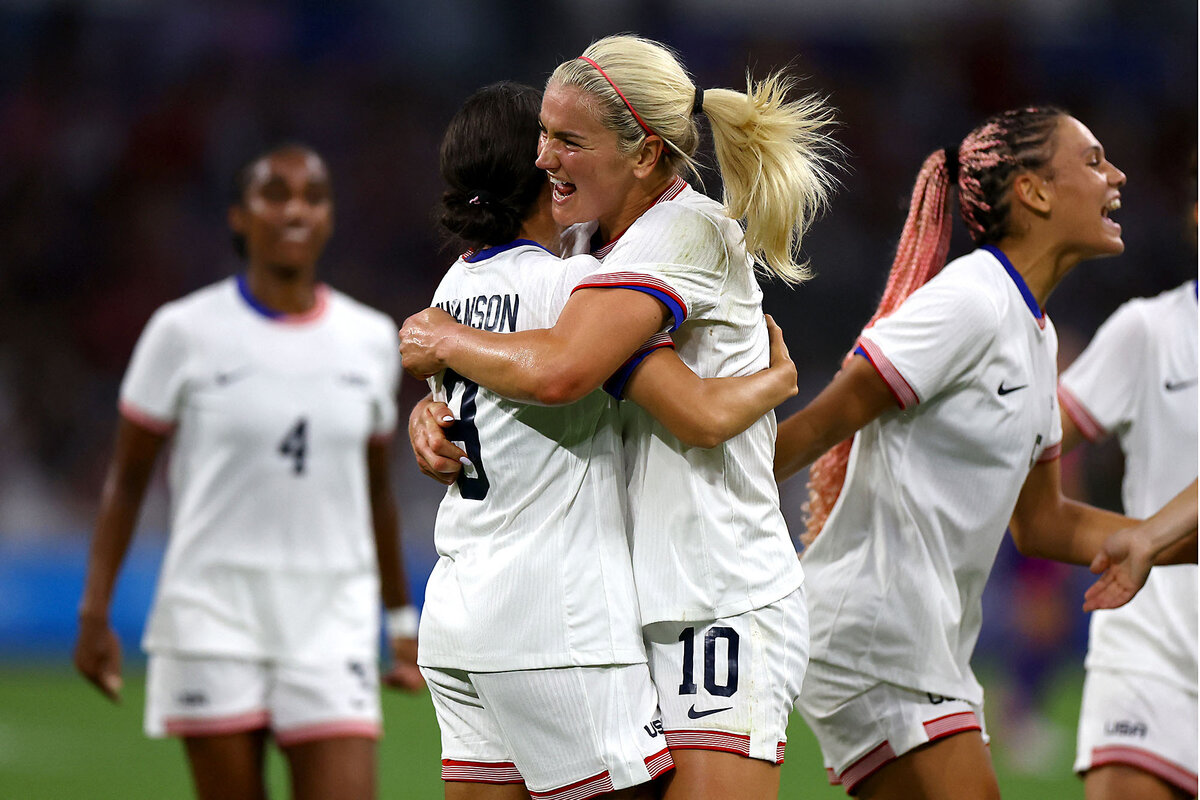Women’s sports are having a moment. The Olympics are showing why.
Loading...
| Paris
When Simone Biles stepped onto the mat for the floor exercise at the gymnastics team final in Paris, Bercy Arena erupted.
“There’s only one gymnast left. Who could it be?” the announcer said, teasing the crowd. She told the fans that Ms. Biles is the most decorated gymnast in history. Could she get another medal?
The answer came quickly, as the U.S. phenom completed the hardest tumbling pass in the world, one where she soars almost 12 feet in the air. After her routine, she blew the crowd a kiss – and the competition away. The U.S. women’s team won the gold medal.
Why We Wrote This
A story focused onEven before the U.S. women’s gymnastics team led by Simone Biles regained its gold medal, women’s sports, such as WNBA games, were proving to be a big draw. How do the Olympics feed this interest?
It’s significant that this celebration of powerful female athletes is happening in Paris. Over a century ago, it was here that women were first allowed to compete in the Games. Back in 1900, only 22 out of about 1,000 athletes were women. Today, the 2024 Olympics is the first in which the number of male and female athletes is roughly equal. Besides Ms. Biles, top female competitors include swimmer Katie Ledecky and track-and-field powerhouse Sha’Carri Richardson.
These Games are happening at a time when women’s sports are seeing an increase in viewership and ticket sales. Though not selected for Team USA, Caitlin Clark helped attract record crowds to the NCAA basketball tournament this spring – and then to her Women’s National Basketball Association games. At the Olympics, Ms. Biles is often the draw, with opening weekend Nielsen and Adobe Analytics ratings showing a bump – to 41.5 million viewers – on the Sunday the U.S. women’s gymnastics team first competed. That was up from about 32 million the day before.
“Women’s sports is booming,” said Crystal Dunn, a veteran member of Team USA’s women’s soccer team, at a media event in the spring. “I think if you’re a female athlete, you’re not surprised. We’re sitting back and we’re kind of like, ‘Yeah, we’ve been telling y’all to invest in women’s [sports].’”
Earlier this year, a survey of more than 14,000 people in seven countries, including the United States, showed global growth in fan interest in women’s sports. Soccer and tennis are the most popular outside of the U.S., where women’s basketball leads. Compared with last year, a quarter to a third of women’s sports fans are watching more in 2024. That includes men, whose watching is up 30% over the previous year.
The increased popularity can be seen in fandom, sponsorships, media rights, ticket sales, and paraphernalia. Female Olympians say that they have felt the surge in appreciation for women’s sports and have enjoyed riding the wave. Their lived experiences have helped interest percolate over the years.
“I’ve actually been having a dream where artistic swimming goes on the same route as women’s basketball,” said Daniella Ramirez, a member of Team USA’s artistic swimming (formerly synchronized swimming) team, while attending the spring media event.
Why Allyson Felix built an Olympic nursery
A factor in the recent growth is women helping other women. Allyson Felix, a track-and-field star with 11 Olympic medals to her name, brought the first-ever Olympic nursery to the athletes village, in partnership with Pampers. She told NBC Olympics that her goal was to “support athletes who are mothers.”
The mother of two – and most decorated woman in track and field – had to compete without a nursery in Tokyo. She picked up two medals, but described the experience of trying to care for her daughter so far from home, and of simultaneously competing on the Olympic stage, as “very challenging.” Ms. Felix wanted to offer other athlete moms a sense of normalcy.
“There are many of us who feel like, when we leave the game we want to have helped push it and make it better than when we found it,” says Ms. Dunn, who has been a member of the U.S. national soccer team since 2012. She credits more investment in the sport and federations committing more resources with helping women’s sports grow and thrive.
What hurdles do women athletes face?
For all their strides, women still work to overcome misperceptions about their physical abilities – and lack of access to high-level coaching jobs. One of Ms. Ledecky’s top events, the 1,500-meter freestyle, only became a women’s event at the Olympics as of 2021 in Tokyo. Men had been competing in the 1,500 since 1904. Ms. Ledecky won gold Wednesday in that event, while also breaking her own Olympic record. She finished 10 seconds ahead of the silver medalist.
Women also face religious barriers. In France, for example, Muslim women on the host country’s Olympic team are not allowed to wear hijabs. France’s explanation is that athletes are considered civil servants and are required to present themselves as secular and neutral. But the ban sparked an international outcry from Muslim athletes, including U.S. fencer Ibtihaj Muhammad and Australian boxer Tina Rahimi. Critics say barring women from wearing the hijab appears to violate the Olympic Charter’s mandate to respect religious rights.
Even with the hurdles, there are signs the gains in popularity will continue. Parity, one of the sponsors of the viewership survey, describes itself as a “sports marketing and sponsorship platform.” It partners with almost 1,100 female athletes, including 260 female Olympians and Paralympians globally, and pairs them with companies. CEO Leela Srinivasan credits a lot of the rising interest to increased availability on media platforms.
“There are so many more options for where you can watch sports,” she says. “If you asked three or four years ago what percentage of media coverage share did women’s sports have, the answer was about 4%. But the last time they gauged it last year, that number had gone up to 15%.”
Ms. Srinivasan says that women popularize sports via social media by building brands and engaging with fans. “Many people watch women’s sports because of the quality that, once you get the exposure, you want to see more of it.”
Why rugby’s Ilona Maher is bigger on social media than Katie Ledecky
The U.S. women’s rugby sevens team won its first-ever Olympic medal this week – a bronze. It was the country’s first rugby medal in a century. Player Ilona Maher is one of the athletes who has used Instagram and TikTok accounts to help build her own brand and get the word out about her sport. With nearly 4 million followers, she has more reach than other U.S. Olympians, including Ms. Ledecky.
“I’m a female athlete in a sport that’s not very big, especially in America. It’s not a money-making sport. ... I want to make sports a career and I don’t think many women can think that way,” she has said, according to The Guardian.
Current and former professional athletes have invested big money in women’s sports. Retired tennis legend Billie Jean King partnered with Mark Walter, an owner of the Los Angeles Dodgers, to start the Professional Women’s Hockey League. Former WNBA champion Sue Bird this year became part owner of the Seattle Storm, the team she played 19 seasons for. And the NBA’s Kevin Durant recently purchased a share of the National Women’s Soccer League Gotham FC.
By some accounts, the representation across platforms, such as TV, is what fuels future generations of athletes. Gabby Thomas, a two-time Olympic medalist in track and field, says that she was inspired by female runners.
“I grew up watching incredible women running. And other than Usain Bolt, the majority of my focus was on watching Allyson Felix, Sanya Richards-Ross, and Carmelita Jeter, and watching these powerhouse women do an amazing job on the track. And I could see myself in that position, and that’s what drew me to [the sport],” Ms. Thomas said at the spring media event.
Ms. Srinivasan, the Parity CEO, believes the momentum will continue to grow because of the infrastructure in place now.
“It’s such an exciting time for anyone who follows women’s sports,” she says, adding that there are daily newsworthy developments happening.
“It’s really hard to keep up,” she says. “We spend all day, every day, thinking about women’s sports.”
How do athletes cope with the pressure of competition? Find out more: They stepped away for mental health. Their comebacks are powering the Olympics.
Ever wonder how Olympic basketball teams are chosen? Read our coverage here.









